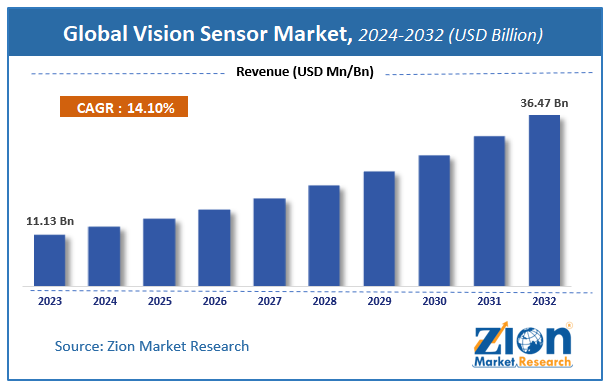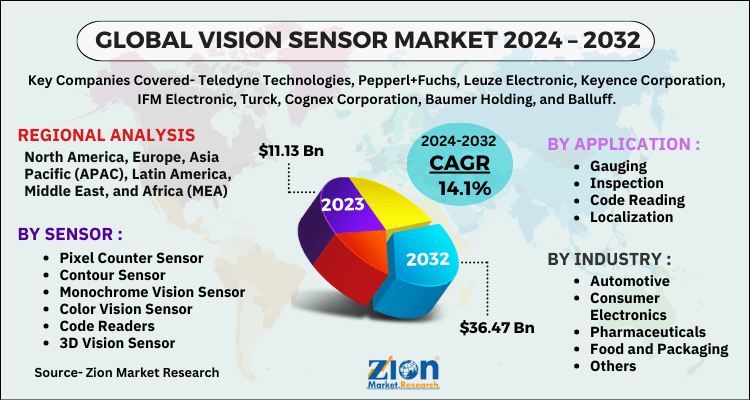Vision Sensor Market Size, Share, Trends, Growth, and Forecast 2032

Vision Sensor Market by Sensor (Pixel Counter, Contour, Monochrome Vision, Color Vision, Code Readers, 3D Vision, and Others), by Application (Gauging, Inspection, Code Reading, and Localization), and by Industry (Automotive, Consumer Electronics, Pharmaceuticals, Food & Packaging, and Others): Global Industry Perspective, Comprehensive Analysis, and Forecast, 2023-2032
| Market Size in 2023 | Market Forecast in 2032 | CAGR (in %) | Base Year |
|---|---|---|---|
| USD 11.13 Billion | USD 36.47 Billion | 14.1% | 2023 |
The global Vision Sensor Market size was worth around USD 11.13 Billion in 2023 and is predicted to grow to around USD 36.47 Billion by 2032 with a compound annual growth rate (CAGR) of roughly 14.1% between 2024 and 2032.
The report covers a forecast and an analysis of the vision sensor market on a global and regional level. The study provides historical data from 2018 to 2022 along with a forecast from 2023 to 2032 based on revenue (USD Billion). The study includes the market drivers and restraints along with their impact on the demand over the forecast period. Additionally, the report includes the study of opportunities available in the vision sensor market on a global level.
Vision Sensor Market: Overview
A vision sensor is a device that combines imaging and image processing skills to collect, analyze, and interpret visual data from its surroundings. These sensors usually contain a camera, a CPU, and software algorithms for detecting, identifying, and measuring objects or
characteristics in acquired images. Vision sensors are available in a variety of formats, including 2D and 3D sensors, each designed to fulfill specific application requirements in the industrial, automotive, and consumer electronics sectors.
These sensors are commonly used in quality inspection, object recognition, and robotic guiding. They ensure product quality by identifying flaws or irregularities on manufacturing lines. Vision sensors play an important role in advanced driver-assistance systems (ADAS), enabling features such as lane departure warnings, automatic emergency braking, and pedestrian identification. Furthermore, in consumer electronics, these sensors improve user experiences by utilizing facial recognition for security and augmented reality applications.
Will Integration of AI and Machine Learning Drive the Vision Sensor Market?
The integration of AI and machine learning has a substantial impact on the vision sensor market by improving the sensors’ capabilities and function. AI algorithms allow vision sensors to execute advanced tasks including object recognition, defect detection, and autonomous decision-making with greater accuracy and speed.
Machine learning algorithms enable vision sensors to learn from data and improve their performance over time, reacting to changing conditions and scenarios. This capacity is especially important in applications such as industrial automation, automated cars, and consumer electronics, where precise and dependable picture analysis is required. As artificial intelligence advances, vision sensors with machine learning capabilities are projected to play an increasingly important role in enabling smarter, more autonomous systems across a wide range of industries.
Also, the growing adoption of Industry 4.0, stresses automation and data interchange in the industrial process. Vision sensors play an important role in this, supplying the visual data required for automated operations and intelligent decision-making. Machine vision technology is constantly advancing, with increased capabilities in image processing, pattern recognition, and object detection. This enables vision sensors to execute more complicated tasks while producing more accurate data.
Will High Initial Costs Hamper the Growth of the Vision Sensor Market?
In the vision sensor market many potential adopters are discouraged from entering due to such challenges, for organizations with low budgets, the initial investment necessary to purchase and integrate vision sensor systems might be prohibitively expensive to purchase. The financial barrier not only blocks the firms’ capacity to implement sophisticated technology for quality control, automation, or safety applications, but it also hinders overall market growth. The idea of high prices could hinder decision-makers from considering vision sensors as a feasible solution, preferring less expensive alternatives or postponing spending entirely.
The current market is facing challenges due to a lack of experienced workers capable of efficiently operating and maintaining these systems. To take full advantage of the potential of vision sensors for tasks such as quality control and automation, specific knowledge in machine vision and data processing is required, which is not always easily available in every region.
Variations in lighting can have an impact on data capturing accuracy, necessitating regulated conditions for maximum performance. Addressing these limits necessitates investment in training programs to develop a qualified workforce, as well as developments in sensor technology to reduce sensitivity to lighting variations, hence encouraging wider adoption and use of vision sensors across industries.
Vision Sensor Market: Segmentation
The global vision sensor market is fragmented on the basis of sensor, application, industry, and region. All the segments have been analyzed based on present and the future trends and the market is estimated from 2024 to 2032.
Based on sensor, the market includes pixel counter, contour, monochrome vision, color vision, code readers, 3D vision, and others. The 3D vision sensors segment will hold a notable share over the projected time period. 1D and 2D sensors, such as monochrome, color, and code readers, are expected to witness a rise in demand by the automotive industry for part inspection applications, pharmaceuticals and food and packaging industries for sorting and text and character recognition.
Vision Sensor Market: Report Scope
| Report Attributes | Report Details |
|---|---|
| Report Name | Vision Sensor Market |
| Market Size in 2023 | USD 11.13 Billion |
| Market Forecast in 2032 | USD 36.47 Billion |
| Growth Rate | CAGR of 14.1% |
| Number of Pages | 182 |
| Key Companies Covered | Teledyne Technologies, Pepperl+Fuchs, Leuze Electronic, Keyence Corporation, IFM Electronic, Turck, Cognex Corporation, Baumer Holding, and Balluff |
| Segments Covered | By sensor, By application, By industry and By Region |
| Regions Covered | North America, Europe, Asia Pacific (APAC), Latin America, Middle East, and Africa (MEA) |
| Base Year | 2023 |
| Historical Year | 2018 to 2022 |
| Forecast Year | 2024 - 2032 |
| Customization Scope | Avail customized purchase options to meet your exact research needs. Request For Customization |
Vision Sensor Market: Regional Analysis
North America is predicted to hold a sizeable share of the global vision sensor market in the years ahead, owing to the early adoption of industry 4.0 and the rising number of smart factory projects. Additionally, the growing demand for machine vision applications in food and packaging and automotive industries is also projected to drive this regional market.
Vision Sensor Market: Competitive Players
Some major players of the vision sensor market are:
- Teledyne Technologies
- Pepperl+Fuchs
- Leuze Electronic
- Keyence Corporation
- IFM Electronic
- Turck
- Cognex Corporation
- Baumer Holding
- Balluff
This report segments the global vision sensor market into:
Vision Sensor Market: Sensor Analysis
- Pixel Counter Sensor
- Contour Sensor
- Monochrome Vision Sensor
- Color Vision Sensor
- Code Readers
- 3D Vision Sensor
- Others
Vision Sensor Market: Application Analysis
- Gauging
- Inspection
- Code Reading
- Localization
Vision Sensor Market: Industry Analysis
- Automotive
- Consumer Electronics
- Pharmaceuticals
- Food and Packaging
- Others
Vision Sensor Market: Regional Analysis
- North America
- The U.S.
- Europe
- UK
- France
- Germany
- Asia Pacific
- China
- Japan
- India
- Latin America
- Brazil
- Middle East and Africa
Table Of Content
Methodology
FrequentlyAsked Questions
Vision sensors are deployed in numerous enterprises and factories for determining the existence and overall orientation with the help of captured camera images.
According to study, the Vision Sensor Market size was worth around USD 11.13 billion in 2023 and is predicted to grow to around USD 36.47 billion by 2032.
The CAGR value of Vision Sensor Market is expected to be around 14.1% during 2024-2032.
North America has been leading the Vision Sensor Market and is anticipated to continue on the dominant position in the years to come.
The Vision Sensor Market is led by players like Teledyne Technologies, Pepperl+Fuchs, Leuze Electronic, Keyence Corporation, IFM Electronic, Turck, Cognex Corporation, Baumer Holding, and Balluff.
RelatedNews
HappyClients
Zion Market Research
Tel: +1 (302) 444-0166
USA/Canada Toll Free No.+1 (855) 465-4651
3rd Floor,
Mrunal Paradise, Opp Maharaja Hotel,
Pimple Gurav, Pune 411061,
Maharashtra, India
Phone No +91 7768 006 007, +91 7768 006 008
US OFFICE NO +1 (302) 444-0166
US/CAN TOLL FREE +1 (855) 465-4651
Email: sales@zionmarketresearch.com
We have secured system to process your transaction.
Our support available to help you 24 hours a day, five days a week.
Monday - Friday: 9AM - 6PM
Saturday - Sunday: Closed







